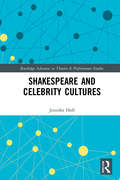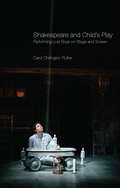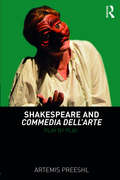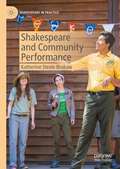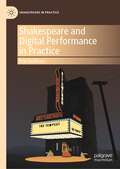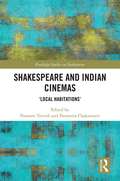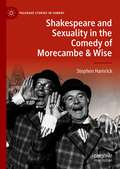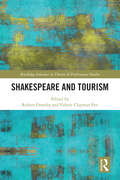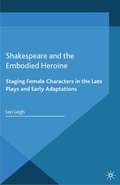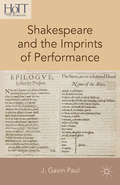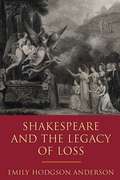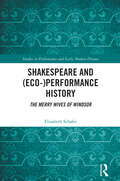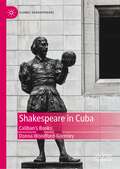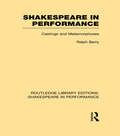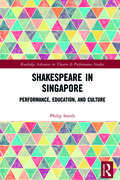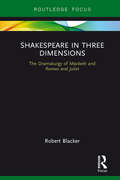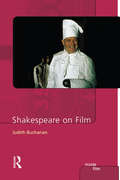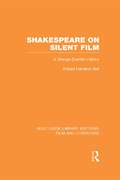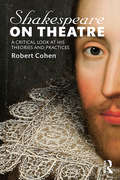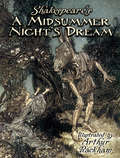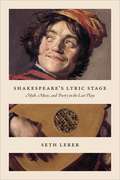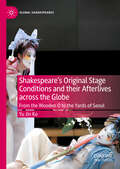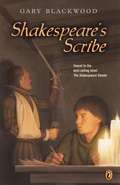- Table View
- List View
Shakespeare and Celebrity Cultures (Routledge Advances in Theatre & Performance Studies)
by Jennifer HollThis book argues that Shakespeare and various cultures of celebrity have enjoyed a ceaselessly adaptive, symbiotic relationship since the final decade of the sixteenth century, through which each entity has contributed to the vitality and adaptability of the other. In five chapters, Jennifer Holl explores the early modern culture of theatrical celebrity and its resonances in print and performance, especially in Shakespeare’s interrogations of this emerging phenomenon in sonnets and histories, before moving on to examine the ways that shifting cultures of stage, film, and digital celebrity have perpetually recreated the Shakespeare, or even the #shakespeare, with whom audiences continue to interact. Situated at an intersection of multiple critical conversations, this book will be of great interest to scholars and graduate students of Shakespeare and Shakespearean appropriations, early modern theater, and celebrity studies.
Shakespeare and Child's Play: Performing Lost Boys on Stage and Screen
by Carol Chillington RutterShakespeare wrote more than fifty parts for children, amounting to the first comprehensive portrait of childhood in the English theatre. Focusing mostly on boys, he put sons against fathers, servants against masters, innocence against experience, testing the notion of masculinity, manners, morals, and the limits of patriarchal power. He explored the nature of relationships and ideas about parenting in terms of nature and nurture, permissiveness and discipline, innocence and evil. He wrote about education, adolescent rebellion, delinquency, fostering, and child-killing, as well as the idea of the redemptive child who ‘cures’ diseased adult imaginations. ‘Childness’ – the essential nature of being a child – remains a vital critical issue for us today. In Shakespeare and Child’s-Play Carol Rutter shows how recent performances on stage and film have used the range of Shakespeare’s insights in order to re-examine and re-think these issues in terms of today’s society and culture.
Shakespeare and Commedia dell'Arte: Play by Play
by Artemis PreeshlShakespeare and Commedia dell’Arte examines the ongoing influence of commedia dell’arte on Shakespeare’s plays. Exploring the influence of commedia dell’arte improvisation, sight gags, and wordplay on the development of Shakespeare’s plays, Artemis Preeshl blends historical research with extensive practical experience to demonstrate how these techniques might be applied when producing some of Shakespeare's best-known works today. Each chapter focuses on a specific play, from A Midsummer Night’s Dream to The Winter’s Tale, drawing out elements of commedia dell’arte style in the playscripts and in contemporary performance. Including contemporary directors’ notes and interviews with actors and audience members alongside Elizabethan reviews, criticism, and commentary, Shakespeare and Commedia dell’Arte presents an invaluable resource for scholars and students of Renaissance theatre.
Shakespeare and Community Performance (Shakespeare in Practice)
by Katherine Steele BrokawThis book explores how productions of Shakespearean plays create meaning in specific communities, with special attention to issues of access, adaptation, and activism. Instead of focusing on large professional companies, it analyzes performances put on by community theatres and grassroots companies, and in applied drama projects. It looks at Shakespearean productions created by marginalized populations in Greater London, Harlem, and Los Angeles, a Hamlet staged in the remote Faroe Islands, and eco-theatre made in California’s Yosemite National Park. The book investigates why different communities perform Shakespeare, and what challenges, opportunities, and triumphs accompany the processes of theatrical production for both the artists and the communities in which they are embedded.
Shakespeare and Digital Performance in Practice (Shakespeare in Practice)
by Erin SullivanShakespeare and Digital Performance in Practice explores the impact of digital technologies on the theatrical performance of Shakespeare in the twenty-first century, both in terms of widening cultural access and developing new forms of artistry. Through close analysis of dozens of productions, both high-profile and lesser known, it examines the rise of live broadcasting and recording in the theatre, the growing use of live video feeds and dynamic projections on the mainstream stage, and experiments in born-digital theatre-making, including social media, virtual reality, and video-conferencing adaptations. In doing so, it argues that technologically adventurous performances of Shakespeare allow performers and audiences to test what they believe theatre to be, as well as to reflect on what it means to be present—with a work of art, with others, with oneself—in an increasingly online world.
Shakespeare and Indian Cinemas: "Local Habitations" (Routledge Studies in Shakespeare)
by Poonam Trivedi Paromita ChakravartiThis book is the first to explore the rich archive of Shakespeare in Indian cinemas, including less familiar, Indian language cinemas to contribute to the assessment of the expanding repertoire of Shakespeare films worldwide. Essays cover mainstream and regional Indian cinemas such as the better known Tamil and Kannada, as well as the less familiar regions of the North Eastern states. The volume visits diverse filmic genres, starting from the earliest silent cinema, to diasporic films made for global audiences, television films, independent films, and documentaries, thus expanding the very notion of ‘Indian cinema’ while also looking at the different modalities of deploying Shakespeare specific to these genres. Shakespeareans and film scholars provide an alternative history of the development of Indian cinemas through its negotiations with Shakespeare focusing on the inter-textualities between Shakespearean theatre, regional cinema, performative traditions, and literary histories in India. The purpose is not to catalog examples of Shakespearean influence but to analyze the interplay of the aesthetic, historical, socio-political, and theoretical contexts in which Indian language films have turned to Shakespeare and to what purpose. The discussion extends from the content of the plays to the modes of their cinematic and intermedial translations. It thus tracks the intra–Indian flows and cross-currents between the various film industries, and intervenes in the politics of multiculturalism and inter/intraculturalism built up around Shakespearean appropriations. Contributing to current studies in global Shakespeare, this book marks a discursive shift in the way Shakespeare on screen is predominantly theorized, as well as how Indian cinema, particularly ‘Shakespeare in Indian cinema’ is understood.
Shakespeare and Sexuality in the Comedy of Morecambe & Wise (Palgrave Studies in Comedy)
by Stephen HamrickContextualizing the duo’s work within British comedy, Shakespeare criticism, the history of sexuality, and their own historical moment, this book offers the first sustained analysis of the 20th Century’s most successful double-act. Over the course of a forty-four-year career (1940-1984), Eric Morecambe & Ernie Wise appropriated snippets of verse, scenes, and other elements from seventeen of Shakespeare’s plays more than one-hundred-and-fifty times. Fashioning a kinder, more inclusive world, they deployed a vast array of elements connected to Shakespeare, his life, and institutions. Rejecting claims that they offer only nostalgic escapism, Hamrick analyses their work within contemporary contexts, including their engagement with many forms and genres, including Variety, the heritage industry, journalism, and more. ‘The Boys’ deploy Shakespeare to work through issues of class, sexuality, and violence. Lesbianism, drag, gay marriage, and a queer aesthetics emerge, helping to normalize homosexuality and complicate masculinity in the ‘permissive’ 1960s.
Shakespeare and Tourism (Routledge Advances in Theatre & Performance Studies)
by Valerie Clayman Pye Robert OrmsbyShakespeare and Tourism provides a dialogical mapping of Shakespeare studies and touristic theory through a collection of essays by scholars on a wide range of material. This volume examines how Shakespeare tourism has evolved since its inception, and how the phenomenon has been influenced and redefined by performance studies, the prevalence of the World Wide Web, developments in technology, and the globalization of Shakespearean performance. Current scholarship recognizes Shakespearean tourism as a thriving international industry, the result of centuries of efforts to attribute meanings associated with the playwright’s biography and literary prestige to sites for artistic pilgrimage and the consumption of cultural heritage. Through bringing Shakespeare and tourism studies into more explicit contact, this collection provides readers with a broad base for comparisons across time and location, and thereby encourages a thorough reconsideration of how we understand both fields.
Shakespeare and the Embodied Heroine: Staging Female Characters in the Late Plays and Early Adaptations (Palgrave Shakespeare Studies)
by L. LeighShakespeare and the Embodied Heroine is a bold new investigation of Shakespeare's female characters using the late plays and the early adaptations written and staged during the seventeenth and eighteenth century.
Shakespeare and the Imprints of Performance (History of Text Technologies)
by J. Gavin PaulWithin the study of drama, the question of how to relate text and performance—and what interpretive tools are best suited to analyzing them—is a longstanding and contentious one. Most scholars agree that reading a printed play is a means of dramatic realization absolutely unlike live performance, but everything else beyond this premise is contestable: how much authority to assign to playwrights, the extent to which texts and readings determine performance, and the capability of printed plays to communicate the possibilities of performance. Without denying that printed plays distort and fragment performance practice, this book negotiates an intractable debate by shifting attention to the ways in which these inevitable distortions can nevertheless enrich a reader's awareness of a play's performance potentialities. As author J. Gavin Paul demonstrates, printed plays can be more meaningfully engaged with actual performance than is typically assumed, via specific editorial principles and strategies. Focusing on the long history of Shakespearean editing, he develops the concept of the performancescape: a textual representation of performance potential that gives relative shape and stability to what is dynamic and multifarious.
Shakespeare and the Legacy of Loss
by Emily Hodgson AndersonHow do we recapture, or hold on to, the live performances we most love, and the talented artists and performers we most revere? Shakespeare and the Legacy of Loss tells the story of how 18th-century actors, novelists, and artists, key among them David Garrick, struggled with these questions through their reenactments of Shakespearean plays. For these artists, the resurgence of Shakespeare, a playwright whose works just decades earlier had nearly been erased, represented their own chance for eternal life. Despite the ephemeral nature of performance, Garrick and company would find a way to make Shakespeare, and through him the actor, rise again. In chapters featuring Othello, Richard III, Hamlet, The Winter’s Tale, and The Merchant of Venice, Emily Hodgson Anderson illuminates how Garrick’s performances of Shakespeare came to offer his contemporaries an alternative and even an antidote to the commemoration associated with the monument, the portrait, and the printed text. The first account to read 18th-century visual and textual references to Shakespeare alongside the performance history of his plays, this innovative study sheds new light on how we experience performance, and why we gravitate toward an art, and artists, we know will disappear.
Shakespeare and: The Merry Wives of Windsor (ISSN)
by Elizabeth SchaferSeismic shifts in the theatrical meanings of The Merry Wives of Windsor have taken place across the centuries as Shakespeare’s frequently performed play has relocated to Windsor across the world, journeying along the production/adaptation/appropriation continuum.This (eco-)performance history of Shakespeare’s The Merry Wives of Windsor not only offers the first in-depth analysis of the play in production, with a particular focus on the representation of merry women, but also utilises the comedy’s forest-aware dramaturgy to explore Mistress Page’s concept of being ‘frugal in my mirth’ in relation to sustainable theatre practices. Herne’s Oak – the fictitious tree in Windsor Forest where everyone meets in the final scene of the play – is utilised to enable a maverick but ecologically based reframing of the productions of Merry Wives analysed here.This study engages with gender, physical comedy, and cultural relocations of Windsor across the world to offer new insight into Merry Wives and its theatricality.
Shakespeare in Cuba: Caliban’s Books (Global Shakespeares)
by Donna Woodford-GormleyShakespeare in Cuba: Caliban’s Books explores how Shakespeare is consumed and appropriated in Cuba. It contributes to the underrepresented field of Latin American Shakespeares by applying the lens of cultural anthropophagy, a theory with Latin American roots, to explore how Cuban artists ingest and transform Shakespeare’s plays. By consuming these works and incorporating them into Cuban culture and literature, Cuban writers make the plays their own while also nourishing the source texts and giving Shakespeare a new afterlife.
Shakespeare in Performance: Castings and Metamorphoses (Routledge Library Editions: Shakespeare in Performance)
by Ralph BerryThese studies take stage history as a means of knowing the play. Half of the studies deal with casting - doubling, chorus and the crowd, the star of Hamlet and Measure for Measure. Then the transformations of dramatis personae are analyzed and The Tempest is viewed through the changing relationships of Prospero, Ariel and Caliban. Some of Shakespeare’s most original strategies for audience control are studied, such as Cordelia's asides in King Lear, Richard II’s subversive laughter and the scenic alternation of pleasure and duty in Henry IV. Performance is the realization of identity. The book draws on major productions up to 1992, just before the book was originally published.
Shakespeare in Singapore: Performance, Education, and Culture (Routledge Advances in Theatre & Performance Studies)
by Philip SmithShakespeare in Singapore provides the first detailed and sustained study of the role of Shakespeare in Singaporean theatre, education, and culture. This book tracks the role and development of Shakespeare in education from the founding of modern Singapore to the present day, drawing on sources such as government and school records, the entire span of Singapore's newspaper archives, playbills, interviews with educators and theatre professionals, and existing academic sources. By uniting the critical interest in Singaporean theatre with the substantial body of scholarship that concerns global Shakespeare, the author overs a broad, yet in-depth, exploration of the ways in which Singaporean approaches to Shakespeare have been shaped by, and respond to, cultural work going on elsewhere in Asia. A vital read for all students and scholars of Shakespeare, Shakespeare in Singapore offers a unique examination of the cultural impact of Shakespeare, beyond its usual footing in the Western world.
Shakespeare in Singapore: Performance, Education, and Culture (Routledge Advances in Theatre & Performance Studies)
by Philip SmithShakespeare in Singapore provides the first detailed and sustained study of the role of Shakespeare in Singaporean theatre, education, and culture. This book tracks the role and development of Shakespeare in education from the founding of modern Singapore to the present day, drawing on sources such as government and school records, the entire span of Singapore's newspaper archives, playbills, interviews with educators and theatre professionals, and existing academic sources. By uniting the critical interest in Singaporean theatre with the substantial body of scholarship that concerns global Shakespeare, the author overs a broad, yet in-depth, exploration of the ways in which Singaporean approaches to Shakespeare have been shaped by, and respond to, cultural work going on elsewhere in Asia. A vital read for all students and scholars of Shakespeare, Shakespeare in Singapore offers a unique examination of the cultural impact of Shakespeare, beyond its usual footing in the Western world.
Shakespeare in Three Dimensions: The Dramaturgy of Macbeth and Romeo and Juliet (Focus on Dramaturgy)
by Robert BlackerIn Shakespeare in Three Dimensions, Robert Blacker asks us to set aside what we think we know about Shakespeare and rediscover his plays on the page, and as Shakespeare intended, in the rehearsal room and in performance. That process includes stripping away false traditions that have obscured his observations about people and social institutions that are still vital to our lives today. This book explores the verities of power and love in Romeo and Juliet and Macbeth, as an example of how to mine the extraordinary detail in all of Shakespeare’s plays, using the knowledge of both theatre practitioners and scholars to excavate and restore them.
Shakespeare on Film
by Judith R. BuchananFrom the earliest days of the cinema to the present, Shakespeare has offered a tempting bank of source material than the film industry has been happy to plunder. Shakespeare on Film deftly examines an extensive range of films that have emerged from the curious union of an iconic dramatist with a medium of mass appeal. The many films Buchanan studies are shown to be telling indicators of trends in Shakespearean performance interpretation, illuminating markers of developments in the film industry and culturally revealing about broader influences in the world beyond the movie theatre. As with other titles from the Inside Film series, the book is illustrated throughout with stills. Each chapter concludes with a list of suggested further reading in the field.
Shakespeare on Screen Othello
by Hatchuel, Sarah and Vienne-Guerrin, Nathalie Sarah Hatchuel Nathalie Vienne-Guerrin"The first volume in the re-launched series Shakespeare on Screen is devoted to Othello, offering up-to-date coverage of recent screen versions as well as new critical essays on older, canonical films. An international cast of authors explores not only productions from the USA and UK, but also translations, adaptations and appropriations in Québec, Italy, India, Brazil and Mexico. The volume takes part in the ceaseless cultural investigation of what Othello says about Shakespeare, the past and our present time, supported by an invaluable film-bibliography. Accompanying free online resources include a fuller version of the bibliography and an additional contribution on YouTube versions of Othello. This book will be a valuable resource for students, scholars and teachers of film studies and Shakespeare studies"--
Shakespeare on Silent Film: A Strange Eventful History (Routledge Library Editions: Film and Literature)
by Robert Hamilton BallIn 1899, when film projection was barely three years old, Herbert Beerbohm Tree was filmed as King John. In his highly entertaining history, Robert Hamilton Ball traces in detail the fate of Shakespeare on silent films from Tree’s first effort until the establishment of sound in 1929. The silent films brought Shakespeare to a wide public who had never had the chance to see his plays in the theatre. And Shakespeare gave the film makers an air of respectability that was badly needed by a medium with a reputation for frivolity. This work, first published in 1968, brings history to life with excerpts from scenarios, from reviews and from contemporary film journals, and with reproduction of stills and frames from the films themselves, including unusual shots of leading screen actors. This is a valuable source book for film experts, enhanced by full notes, bibliography and indexes; a fresh approach for Shakespeareans; and a vivid sketch of a world that has passed for all.
Shakespeare on Theatre: A Critical Look at His Theories and Practices
by Robert CohenIn Shakespeare on Theatre, master acting teacher Robert Cohen brilliantly scrutinises Shakespeare's implicit theories of acting, paying close attention to the plays themselves and providing a wealth of fascinating historical evidence. What he finds will surprise scholars and actors alike – that Shakespeare's drama and his practice as an actor were founded on realism, though one clearly distinct from the realism later found in Stanislavski. Shakespeare on Acting is an extraordinary introduction to the way the plays articulate a profound understanding of performance and reflect the life and times of a uniquely talented theatre-maker.
Shakespeare's A Midsummer Night's Dream
by William Shakespeare Arthur RackhamShakespeare's incomparable romantic comedy takes on a new and vivid life in these brilliant images by one of the 20th century's leading illustrators. The fairy world of A Midsummer Night's Dream is the perfect milieu for the artistry of Arthur Rackham, a popular illustrator of fairy tales who possessed a striking gift for depicting fanciful creatures. His dreamlike visions provide a series of unique portraits from the enchanted wood outside ancient Athena, where Oberon and Titania rule a kingdom of diminutive sprites. <p><p> Rackham's career coincided with the era known as the Golden Age of Illustration, an age that witnessed the rise of increasingly sophisticated color printing techniques. His interpretation of A Midsummer Night's Dream, which first appeared in 1908, received the full benefit of the improved technology, and this faithful reprint offers a quality of printing and sharpness of reproduction that rivals the limited and first editions. The complete text of the play appears here, along with 40 full-color and numerous black-and-white illustrations — a splendid tribute by a master of fantasy art to an immortal play.
Shakespeare's Lyric Stage: Myth, Music, and Poetry in the Last Plays
by Seth LererWhat does it mean to have an emotional response to poetry and music? And, just as important but considered less often, what does it mean not to have such a response? What happens when lyric utterances—which should invite consolation, revelation, and connection—somehow fall short of the listener’s expectations? As Seth Lerer shows in this pioneering book, Shakespeare’s late plays invite us to contemplate that very question, offering up lyric as a displaced and sometimes desperate antidote to situations of duress or powerlessness. Lerer argues that the theme of lyric misalignment running throughout The Tempest, The Winter’s Tale, Henry VIII, and Cymbeline serves a political purpose, a last-ditch effort at transformation for characters and audiences who had lived through witch-hunting, plague, regime change, political conspiracies, and public executions. A deep dive into the relationship between aesthetics and politics, this book also explores what Shakespearean lyric is able to recuperate for these “victims of history” by virtue of its disjointed utterances. To this end, Lerer establishes the concept of mythic lyricism: an estranging use of songs and poetry that functions to recreate the past as present, to empower the mythic dead, and to restore a bit of magic to the commonplaces and commodities of Jacobean England. Reading against the devotion to form and prosody common in Shakespeare scholarship, Lerer’s account of lyric utterance’s vexed role in his late works offers new ways to understand generational distance and cultural change throughout the playwright’s oeuvre.
Shakespeare's Original Stage Conditions and their Afterlives across the Globe: From the Wooden O to the Yards of Seoul (Global Shakespeares)
by Yu Jin KoThis book brings together two separate fields by combining a study of Shakespeare's original stage conditions with an exploration of his plays in performance across the globe. The book contributes new insights into how early-modern stage conditions shaped the writing, production, and reception of Shakespeare's plays, but takes the further step of examining how original stage conditions re-emerge, not only in Globe replicas like the London Globe, but in unexpected and sometimes unconscious reconfigurations in adaptations and productions from around the world: film versions of Othello from Mexico to India that take dancing cues and anxieties about dance from the play and centralize dance; Korean adaptations for the madang (or yard) that reimagine Shakespeare's theatrical spaces and their relationships to audiences; Noh re-imaginings on film and onstage that foreground the theatrical; a teen film remake of Othello that raises questions about how blackness is figured today and on Shakespeare's stage, among others. By studying original stage conditions and their global afterlives, the book illuminates how global productions negotiate historical and cultural differences and thereby, paradoxically, engage with the cultural specificities of the present.
Shakespeare's Scribe
by Gary BlackwoodWhen an outbreak of the deadly Black Plague closes the Globe Theatre, William Shakespeare's acting troupe sets off on a tour of England. Widge, the orphan-turned-actor, knows that he'll be useful on the trip. Not only does he love the stage, but his knack for a unique shorthand has proven him one of the most valuable apprentices in the troupe. But then a mysterious man appears, claiming to know a secret from Widge's past-a secret that may forever force him from the theatre he loves. "An exciting, well-written tale that is sure to leave [readers] clamoring for more. " (School Library Journal, starred review) .
